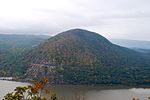Pollepel Island
Castles in the United StatesCommons category link is locally definedFishkill, New YorkIslands of Dutchess County, New YorkIslands of the Hudson River ... and 6 more
Landmarks in New York (state)National Register of Historic Places in Dutchess County, New YorkRiver islands of New York (state)Ruins in the United StatesUninhabited islands of New York (state)Vague or ambiguous time from October 2021

Pollepel Island is a 6.5-acre (26,000 m2) uninhabited island in the Hudson River in New York. The principal feature on the island is Bannerman's Castle, an abandoned military surplus warehouse.
Excerpt from the Wikipedia article Pollepel Island (License: CC BY-SA 3.0, Authors, Images).Pollepel Island
Wee Bay Steps,
Geographical coordinates (GPS) Address Nearby Places Show on map
Geographical coordinates (GPS)
| Latitude | Longitude |
|---|---|
| N 41.455314 ° | E -73.98887 ° |
Address
Bannerman Family Residence
Wee Bay Steps
12520
New York, United States
Open on Google Maps











